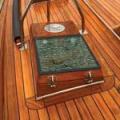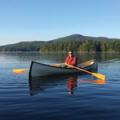On the Town Dock — Issue 150
Rowboats, bomb storms, no shrimp
 Illustration by Ted Walsh
Illustration by Ted Walsh
Row, row, row to school
Getting to school in rural Maine can be a challenge. We’ve all heard stories about long bus rides, but what about boat rides?
Five students, ages 5 to 13, who live on Islesford, rowed to school on Great Cranberry Island and back most days last fall, according to an article in the Ellsworth American.
Rowing with them and making sure they were safe was Tony Archino, who teaches boatbuilding with Islesford Boatworks. He came up with the idea.
On days when the weather was good, some or all of the Islesford students rowed the half mile or so over to Great Cranberry and Longfellow School in the morning and back home in the afternoon. It takes about half an hour to row from one island to the other. Sometimes, Longfellow Principal Lindsay Eysnogle, who also lives on Islesford, rowed with the students. They took the mailboat when winds or rain made the crossing too rough. Their boat was a 22-foot St. Ayles skiff.
Support for edible “weed” research
No, not that kind—seaweed. Several recent grants to Maine organizations are intended to promote edible seaweed production in Maine.
The National Oceanic and Atmospheric Administration awarded $908,015 to the University of Maine for research into sustainable post-harvest processing (such as drying, blanching, and freezing) of aquacultured seaweed and development of value-added products. The goal is to increase the capacity of Maine seaweed producers and processors.
Meanwhile, the University of New England landed a U.S. Department of Energy grant for $1.32 million to develop a three-dimensional modeling tool to simulate hydrodynamic-induced mechanical stresses that seaweed farms face in the open ocean. That data could then be used to determine the structural performance of new and existing farm designs in the Gulf of Maine.
A day with yacht designers
Lyman-Morse Boatbuilding and the Cruising Club of America hosted a Yacht Designers Forum at the yard in Thomaston last October. The morning session was held on the third floor mezzanine of their boatshop. Nine of today’s best yacht designers exhibited small displays of their current work to share their knowledge with those of us who love boats, profess to know something about boats, and who quickly realized that these guys really know about boats. It was heady stuff.
The Forum later moved to the Farnsworth Art Museum’s Wyeth Center for two sold-out panel discussions looking at the challenges facing the sport of boats, and the advances in the various aspects of design, ranging from propulsion, which is going through an incredible evolutionary spurt, through onboard systems, and the future of foiling.
Participating yacht designers included: Peter Boyce of C. Raymond Hunt; Scott Jutson of Jutson Marine Design; David McCollough of McCollough Yachts; Ed Joy of Ed Joy Yacht Design; Chuck Paine of CW Paine Yacht Design; Jay Paris of Jay E. Paris Naval Architecture; Bob Stephens of Stephens Waring Yacht Design; Jim Taylor of Jim Taylor Yacht Designs; Paul Waring of Stephens Waring Yacht Design; and Doug Zurn of Zurn Yacht Design. To view the forum video CLICK HERE.
Salmon woes
Despite lots of attention and effort, wild salmon runs in the northeast have not been doing as well as some might hope. For the first time in 25 years of monitoring no wild Atlantic salmon returned from the sea this year to the Magaguadavic River fishway in New Brunswick, Canada, according to a report in the Quoddy Tides. This led to renewed charges by a wild salmon conservation organization about the impact of farmed salmon escapees on wild salmon runs. However, an area fish farming association defended the industry’s practices and called for a new approach to help the wild salmon population recover, according to the newspaper’s report.
In 1983 the Department of Fisheries and Oceans estimated that 900 wild salmon entered the Magaguadavic River to spawn. But despite a multi-year cooperative stocking program, the number of wild salmon in the river continued to drop. The Atlantic Salmon Federation says the loss of wild Magaguadavic River salmon is another blow to the Outer Bay of Fundy population.
Atlantic salmon populations are affected globally by changing ocean conditions and overfishing.
The news was not all bad. The only native populations of Atlantic salmon left in the U.S. are in Maine, where the most active salmon river is the Penobscot River. Dan Kircheis, a fisheries biologist with the National Marine Fisheries Service, has said nearly 850 salmon returned to the river in 2017, an improvement from 261 in 2014, but still fewer than more than the 1,950 that returned in 2009, according to fisheries service statistics.
The improvement could be due to dam removals. Two dams on the lower Penobscot—one in Veazie, and one at Great Works—were removed over the past five years, dramatically increasing access to upstream habitat.
New breakwater in Eastport
While dams have come down on Maine rivers, a barrier went up in Eastport, which was good news for fishermen and other local boaters. Finishing touches on the new $15 million breakwater were due to be completed last fall with the installation of new floats alongside.
Construction of the 100-foot-by-400-foot pier began after a catastrophic collapse of the inner half of the breakwater on Dec. 4, 2014. The new breakwater, which protects Eastport’s inner harbor and marina, is the same size, but was built 50-feet farther from the original pier, according to an article in The Working Waterfront.
The project was completed by CPM of Freeport.
The new steel pilings were driven into the ocean floor and filled with concrete, which was then topped with a concrete deck. The new pier also includes composite materials in place of steel in some parts since the plastic does not rust or otherwise decay.
The port is deep enough to be accessed by container ships and remains active throughout the winter because the action of the 25-foot tides prevents the water from freezing.
Endangered right whales
Scientists who study the North Atlantic right whale estimate that the species will be doomed to extinction by 2040 if humans don’t make substantive changes to protect them, according to a report in the Portland Press Herald.
A record 16 of the endangered whales were found dead last summer and fall, which is a lot considering that the estimated worldwide population of right whales is just 450.
“At the rate we are killing them, we will have wiped out all existing breeding females in 23 years. That’s a very short period of time,” said Mark Baumgartner, a scientist from Woods Hole Oceanographic Institution. He chairs an international study group that convened the North Atlantic Right Whale Consortium in Halifax, Nova Scotia, last fall.
Scientists at the meeting said options for saving the whales include making the ropes used in lobster and crab fisheries less deadly for the whales, and developing ropeless trap technologies in the future.
The whales, many of which traditionally came to the waters off Lubec and Grand Manan Island, New Brunswick, in late summer to feed, began turning up dead in early June. Canadian authorities documented 12 dead right whales in the Gulf of St. Lawrence, while another four were found in the waters around Cape Cod.
Conclusive necropsies for five of the whales found off Canada showed that one had become entangled in snow-crab fishing gear and four were apparently struck by ships. An additional whale showed signs of an “acute” death, suggestive of a ship strike, according to a report by the Fisheries and Oceans Canada.
A necropsy performed on one of the four carcasses found around Cape Cod also determined it died of a blunt force trauma. Two other bodies were too decomposed to make a judgment.
All aboard, next stop Rockland, Maine
Coastal communities were thrilled this winter with the news that passenger train service could extend north of Brunswick. A proposed schedule for the pilot Downeaster Amtrak passenger train service along the coast to Rockland was being developed, with regular seasonal runs beginning as early as May. The Downeaster currently runs from Boston to Portland and on to Brunswick with some stops in between. The longer weekend runs would include stops in Bath, Wiscasset, Newcastle, and Rockland.
Patricia Quinn, the executive director of the Northern New England Passenger Rail Authority, told Rockland City Manager Tom Luttrell that the pilot program is still in the exploratory stage, according to a story in the Bangor Daily News. The rail authority planned to do some test runs along the line in December and to hold forums in communities where the trains will stop to gather public feedback.
Possible schedules were still being developed but the most recent proposal in late November was for the service to run May through October on weekends. The tentative schedule called for a train to leave Boston at 5 p.m. Friday and reach Rockland at 10:30 p.m. On Saturdays and Sundays, a train would leave Boston at 9:45 a.m. and arrive in Rockland at 3:20 p.m., Quinn said. The train would then leave Rockland at 3:55 p.m. and arrive back in Boston at 9:25 p.m.
This schedule was designed to attract Boston area residents who want to avoid the heavy car traffic on summer weekends.
Regular commuter train service ended in Rockland in 1959.
Maine Eastern Railroad offered seasonal excursion passenger service between Rockland and Brunswick until 2015 when the state ended its contract with Maine Eastern Railroad and awarded a contract to Central Maine & Quebec Railway.
Freight continues to run on the line.
No shrimp fishing again this winter
Despite several years with no commercial harvest of northern shrimp, the population of the tiny prawns (Pandalus borealis) remains too low to allow the fishery to be re-opened.
The Atlantic States Marine Fisheries Commission’s Northern Shrimp Section on Nov. 30 extended its moratorium on commercial fishing for the 2018 season, according to a news release. The good news is that, as in past years, the section did approve a 13.3 metric ton research set aside, which means a limited amount of shrimp likely will be available for sale this winter. Stay tuned for additional details.
The 2017 Stock Status Report for Gulf of Maine Northern Shrimp showed abundance and biomass indices for 2012–2017 are the lowest on record of the 34 year time series, with 2017 being the lowest observed. Recruitment since 2011 has been poor and includes the four smallest year classes on record, according to fisheries scientists.
Recruitment of northern shrimp is related to both spawning biomass and ocean temperatures, with higher spawning biomass and colder temperatures producing stronger recruitment. Ocean temperatures in western Gulf of Maine shrimp habitat have increased over the past decade and reached unprecedented highs in the past several years. While 2014 and 2015 temperatures were cooler, 2016 and 2017 temperatures were again high, and the temperature is predicted to continue rising as a result of climate change. This suggests an increasingly inhospitable environment for northern shrimp and the need for strong conservation efforts to help restore the stock.
In 2013, the most recent year the fishery was open, fewer than 600,000 lbs. of shrimp were harvested in the gulf.
History being lost to shore erosion
Warm oceans and rising sea levels have been taking a toll on shore, as well.
Some 2,000 known shell middens in Maine are seriously threatened by rising sea levels, beach erosion, and real estate development, according to an article in the Bangor Daily News. Middens mark spots where Maine’s Native Americans feasted on clams, shells, and other seafood, then tossed aside the remains. These ancient garbage heaps contain information about Maine’s early environment and long-ago residents.
A University of Maine project, funded by Maine Sea Grant, seeks to define the current extent of the middens and develop a network of citizen scientists to monitor and protect them.
“The paleo information is priceless,” Alice Kelley, an associate research professor at the University of Maine Climate Change Institute, told the BDN. “The bones and the things that are there are basically our only record of what was living in the western Gulf of Maine from 4,000 years ago to the present.”
Over the last two years, she and a UMaine crew have used ground-penetrating radar to define the thickness and extent of many of these middens. The project’s next step, Kelley said, will be to develop a protocol for a network of citizen “midden minders.” She also will help set up a website so the citizen scientists can send in their photos and data. Prospective minders are invited to send her an email at akelley@maine.edu.
Who dropped the “bomb” on Maine?
The type of storm that hit New England in late October, knocking out power to over 500,000 Maine homes, was an unusual meteorological event that weather forecasters referred to as a “bomb cyclone.”
The unusual nickname stems from a phenomenon in which atmospheric pressure drops relatively quickly (technically, 24 millibars in 24 hours), whipping up the kind of sudden strong winds that hit the state in late October, according to a report in the BDN. Tens of thousands of Mainers went without power for more than a week as power crews came from across the country to help restore downed lines.
The storm formed as moisture from Tropical Storm Philippe merged with an eastward-moving cold front, causing a rapid drop in air pressure and powerful winds. A weather buoy at Matinicus Rock in the Gulf of Maine recorded a wind gust of 92 mph while another at Isle of Shoals, on the Maine-New Hampshire border, recorded a wind gust of 82 mph, according to the National Weather Service. Damage in coastal harbors was extraordinary.
At least six boats broke loose in Belfast and two were total losses. In Rockland, a local lobsterman’s boat was smashed up against rocks, creating large holes in the boat’s hull. A sailboat from Owls Head also was totaled. In Stonington, one commercial boat and a sailboat were destroyed, according to harbormaster Raelene Pert.
The governor has asked for a disaster declaration to help the state recover from the storm, which knocked down more than 1,400 utility poles. Damage to public infrastructure exceeded $4.7 million, according to the governor’s request.
New buildings for Artisan
Artisan Boatworks in Rockport, Maine, has added a new storage building and paint bay to keep pace with its growing maintenance and storage business.
Since starting the business in 2002, owner Alec Brainerd has carved out a niche restoring and building classic wooden sailboats and motoryachts. In recent years, the yard also has seen an increase in storage and maintenance work. The yard now employs 18 people.
The new 5,800-square-foot storage building is an unheated wood-framed pole barn with metal siding and dirt floors that are better for wooden boat storage. The 1,600-square-foot paint shop features controls for humidity, dust, and ventilation, with heat provided by fast and efficient hot-water convectors, Brainerd said. The new structures bring the yard’s total building area to approximately 21,000 sq. ft.
John Davee and his crew at Maine Coast Construction did the work. The yard received financial assistance from Eastern Maine Development and Bangor Savings Bank, Brainerd said.
MBH&H turns 30 and wins awards
Maine Boats, Homes & Harbors magazine celebrated 30 years in print this fall, which happened to coincide with receiving some well-deserved honors from our publishing peers.
The magazine won two honorable mentions for editorial excellence in Folio’s prestigious national magazine contest for 2017, and six more awards in the International Regional Magazine Association’s 2017 contest.
The Folio “Eddies” were for general excellence in the Automotive/Enthusiast category, and for a story by MBH&H Editor Polly Saltonstall in that same category about charting the coastline.
IRMA awarded the magazine silver medals in the following categories: Illustration, for a drawing of a caretaker closing up a house by Caroline Magerl; Art and Culture Feature, for a story by Ann Dodds Costello about the Van Campen family of artists; and Historical Feature in the under 30,000 circulation category for Rob McCall’s story about John J. Audubon and his travels in Maine. MBH&H won bronze medals in the General Feature category for a story by Paul Molyneaux about Eastport’s pilots and in the Photos Series for magazines in the under 30,000 circulation category for Robert F. Bukaty’s photos of dredging in the Royal River. Peter H. Spectre won an award of merit in the Column category for his Postcard in Time column series.
For links to the stories, CLICK HERE
Related Articles
Share this article:
2023 Maine Boat & Home Show

Join Us for the Maine Boat & Home Show!
Art, Artisans, Food, Fun & Boats, Boats, Boats
August 11 - 13, 2023 | On the waterfront, Rockland, Maine
Click here to pre-order your tickets.
Show is produced by Maine Boats, Homes & Harbors magazine.















